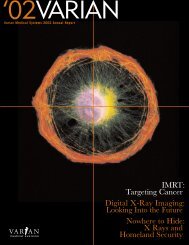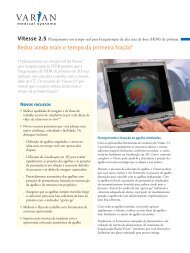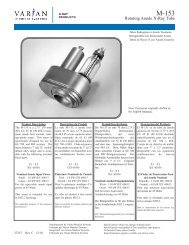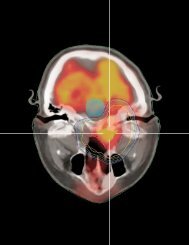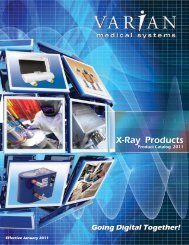G-1582BI:G1582tri rev B.qxd.qxd - Varian
G-1582BI:G1582tri rev B.qxd.qxd - Varian
G-1582BI:G1582tri rev B.qxd.qxd - Varian
You also want an ePaper? Increase the reach of your titles
YUMPU automatically turns print PDFs into web optimized ePapers that Google loves.
X-RAY<br />
PRODUCTS<br />
General: Serial Radiography puts a severe demand<br />
on the x-ray tube due to the large number of exposures<br />
made in rapid succession. Intervals between<br />
exposures are fixed and so short that it is not possible<br />
for the anode track to cool to any extent during the<br />
exposure series. Therefore, the temperature of the<br />
anode track increases from exposure to exposure.<br />
The kW values used in the angiographic charts have<br />
been determined to p<strong>rev</strong>ent damage to the anode.<br />
The angiographic rating charts are usable to maximum<br />
anode heat content.<br />
Definition of Terms<br />
Number of Exposures in Series: The number of<br />
exposures made in succession or the number of exposures<br />
made during one contrast injection.<br />
Exposure Rate: The number of exposures made per<br />
second. For a series of exposures where the exposure<br />
rate changes, it must be assumed that all exposures<br />
will be made at the maximum rate. For example,<br />
if during a series 10 exposures will occur at one<br />
per second and 30 exposures at 4 per second, use the<br />
kW ratings in the 40 exposure column at 4 per second<br />
rate.<br />
Exposure Time: Time in seconds of Each exposure.<br />
ANGIOGRAPHIC RATINGS<br />
HOW TO USE ANGIOGRAPHIC CHARTS<br />
Copyright © 2007, <strong>Varian</strong> Medical Systems. All Rights Reserved.<br />
8<br />
G-<strong>1582BI</strong><br />
Angiographic Ratings<br />
USING THE CHARTS:<br />
Select Correct Chart:<br />
0.3, 0.6 or 1.0 Focal Spot<br />
Note: 150/180 HZ rotor speed recommended for<br />
all angiography.<br />
Determine the number of exposures in Series: With<br />
cut film angiography the number of exposures are<br />
known, however in Digital Angiography the number of<br />
exposures commonly are not known. When determining<br />
the number of exposures, assume worst case or past<br />
history.<br />
Note: Most angiographic x-ray tubes fail from underestimating<br />
the number of exposures made in a series.<br />
Determine kW of each exposure in Series: Referring<br />
to chart ⎯find block under “Number of Exposures in<br />
Series” that is greater than or equal to expected number<br />
of exposures in Series. On left side directly opposite this<br />
block under “Exposure Rate per Second” column, select<br />
maximum rate per second that will be used for the exposure<br />
series. At the intersection of exposure rate and<br />
exposure time in seconds, find maximum kW allowed for<br />
each exposure.<br />
For Example: 80 pkV and 500 mA = 40 kW<br />
Example: From chart G-<strong>1582BI</strong> 150/180 HZ 3 Phase<br />
1.0 Focal Spot, determine kW allowed with<br />
following known factors.<br />
Maximum number of exposures ..............40<br />
Exposure time .050 second (50 milliseconds)<br />
Maximum Exposure per second ..............4<br />
From chart find 40 exposure block. On left side directly<br />
opposite this block under “Exposure Rate per Second”<br />
column, select 4 exposures per second. Find .050<br />
seconds at top of chart. At intersection of exposure rate<br />
line and exposure time, find 77.4 kW.


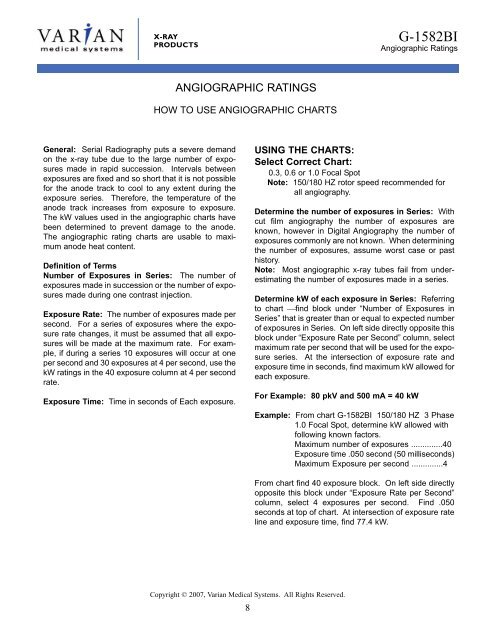

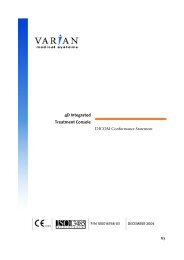

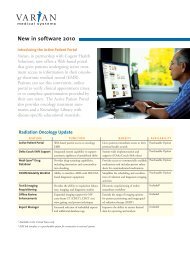
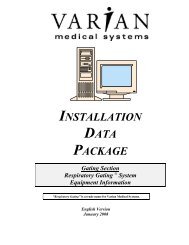
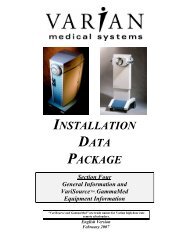
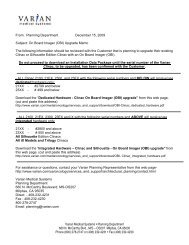
![[MSDS 126] Dow Corning 200 Fluid, 5 CST Part Number ... - Varian](https://img.yumpu.com/5104917/1/190x245/msds-126-dow-corning-200-fluid-5-cst-part-number-varian.jpg?quality=85)

